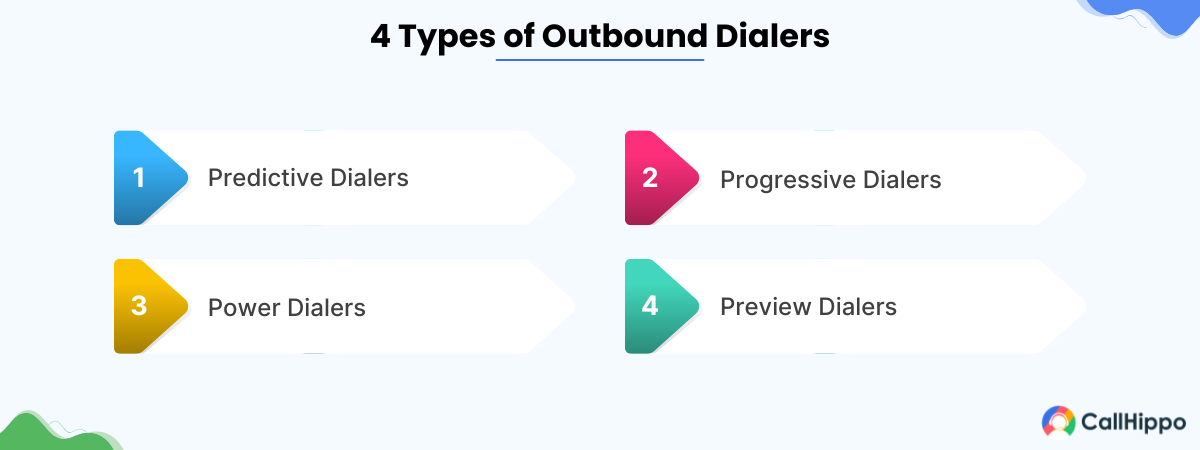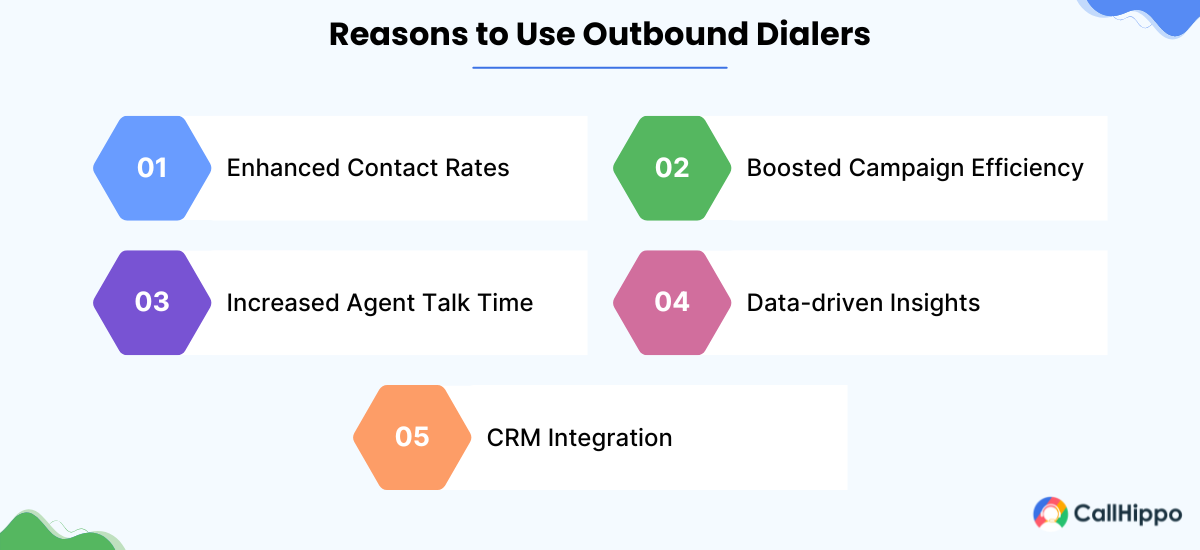Businesses are continuously searching for methods to improve productivity, simplify client contacts, and increase sales in the area of contemporary communication. One tool that has become indispensable for achieving these goals is the outbound dialer.
Whether you’re managing a sales team, running a marketing campaign, or following up with customers, outbound dialers can improve the way you connect with your audience.
This blog explores everything you need to know about outbound dialers, their types, benefits, use cases, and implementation strategies.
What Are Outbound Dialers?
An outbound dialer is a software system designed to automate the process of making outgoing calls. These tools eliminate the need for manual dialing, allowing agents to focus on meaningful conversations rather than wasting time on repetitive tasks.
With features like automated call routing, real-time monitoring, and campaign tracking, outbound dialers are essential for any business looking to improve contact rates and maximize productivity.
When choosing an outbound dialer, prioritize efficiency, compliance, and scalability. Use predictive dialers for high-volume campaigns, and ensure integration with CRM systems for seamless operations. Always stay updated on regulatory requirements.
Types of Outbound Dialers
Different types of outbound dialers cater to various business needs. Understanding these types can help you choose the right solution for your organization.

1. Predictive Dialers
Predictive dialers use algorithms to automatically dial multiple numbers at once, predicting when an agent will be free to take the next call. By doing this, they reduce idle time for agents and increase overall productivity. This type of system is ideal for large-scale operations with a high call volume, as it helps optimize outbound call campaigns and ensures that calls are connected when agents are available, improving efficiency and performance.
An outbound dialer with the capability to assess and anticipate call center capacity can significantly enhance operational efficiency. For call centers looking to maximize their outreach, implementing the right call center dialer can make all the difference in achieving their performance goals. A predictive dialer, for instance, optimizes resource utilization by initiating multiple calls per agent simultaneously, ensuring minimal idle time. When effectively implemented, predictive dialers have the potential to increase the number of successful connections by nearly 400%, making it a powerful tool for boosting overall productivity.
2. Progressive Dialers
Progressive dialers call one number at a time and only connect the call once an agent is ready to speak. Unlike predictive dialers, they don’t over-dial, which reduces the chances of abandoned calls. This type of dialer is perfect for businesses that prioritize customer satisfaction and aim to avoid reaching voicemail. Progressive dialers offer a balanced approach, maintaining efficiency without sacrificing the quality of the customer experience.
Progressive dialers allow for a balanced approach to call management, optimizing agent productivity without compromising the quality of the customer experience. This type of dialer is ideal for businesses focused on customer-centric services, as it enables agents to engage with each caller individually and provide personalized attention. It also helps businesses avoid the high abandonment rates typically associated with predictive dialing systems, making it a valuable tool for contact centers
3. Power Dialers
Power dialers automatically call numbers from a pre-uploaded list without requiring agent input. Once the call connects, it is instantly transferred to an available agent. This system works best for medium-sized teams looking to optimize their outbound calling campaigns. By reducing the manual work of dialing, power dialers allow agents to focus on conversation rather than administrative tasks, improving overall productivity and streamlining workflows.
Power dialers are especially effective for medium-sized teams that need to optimize their outbound calling campaigns. Since the system handles the dialing process, it eliminates the need for agents to manually input numbers or waste time dialing multiple times, which can be tedious and prone to human error.
4. Preview Dialers
A preview dialer stands out as a top-tier automated tool that streamlines operations by organizing and presenting filtered customer data, enabling agents to focus on meaningful interactions.
Preview dialers give agents the opportunity to review customer information before making a call, allowing for more personalized interactions. This feature is especially valuable for businesses where the relationship with the customer is key, such as in high-value sales or customer retention. By having key details about the customer in advance, agents can tailor their approach, leading to more successful interactions and higher customer satisfaction.
Why Use Outbound Dialers?
The benefits of outbound dialers go far beyond just automating calls. Here are some key reasons why businesses choose these tools:

1. Enhanced Contact Rates
Outbound dialers improve contact rates by automating tasks like redialing and scheduling calls, ensuring businesses reach prospects at the best times. This means fewer missed calls and more opportunities to connect with potential customers.
By optimizing the timing and targeting of calls, businesses can increase their outreach effectiveness and make the most of every call. With these tools, reaching the right audience at the right time becomes easier, ultimately improving the chances of successful engagement and better campaign outcomes.
2. Boosted Campaign Efficiency
An automated outbound dialer eliminates the inefficiencies of manual dialing, allowing agents to focus more on talking to prospects than manually dialing numbers. This reduces downtime and increases the number of calls agents can make in a given time.
As a result, campaigns run more smoothly and are completed faster. Businesses can reach more people with less effort, making outbound campaigns much more efficient. This improves overall productivity and allows teams to meet their goals quickly and effectively.
3. Increased Agent Talk Time
Agents spend less time dialing and more time speaking with prospects. This not only boosts productivity but also improves job satisfaction, as agents can focus on meaningful conversations rather than repetitive tasks. Not only does this boost productivity, but it also improves agent job satisfaction, as they get to engage with customers more rather than spending time on administrative work. This focus on conversation helps build stronger relationships with prospects.
Automatic dialers for call centers can increase agent talk time by up to 300%, allowing them to engage with more prospects in less time.
4. Data-driven Insights
Modern outbound dialers provide detailed analytics on call performance, helping businesses make informed decisions. From call durations to success rates, these insights enable teams to refine their strategies and achieve better outcomes.
With these insights, businesses can optimize their campaigns, enhance targeting efforts, and improve overall efficiency, ensuring that resources are used effectively for maximum impact.
5. CRM Integration
Seamless integration with Customer Relationship Management (CRM) systems ensures that all customer data is accessible in one place. This helps agents personalize their interactions and maintain consistent communication throughout the customer journey.
Having everything in one place helps agents maintain consistent communication and better manage follow-ups. By streamlining access to key data, businesses can improve customer relationships, increase satisfaction, and ultimately enhance the chances of conversion and loyalty, creating a more seamless customer experience.
Use Cases and Examples of Outbound Dialers
Outbound dialers offer versatile solutions for businesses across industries. From boosting sales and improving customer service to managing collections and driving nonprofit campaigns, their applications are vast and impactful. Below, we’ll dive into specific use cases and provide examples of how businesses can leverage these tools to achieve their goals.
1. Sales and Marketing
Sales teams use outbound call dialers to reach potential customers, promote products, and close deals. Marketing campaigns also benefit from these tools by ensuring timely follow-ups and increasing conversion rates. After automating these processes, businesses can achieve greater outreach and higher revenues.
Sales and Marketing: Salesforce
Salesforce, a leader in CRM software, uses outbound dialers to support its sales teams in reaching prospects more efficiently. By integrating dialers with their CRM, Salesforce agents can access customer data during calls, enabling personalized pitches. This approach has helped them significantly increase conversion rates and streamline their lead management process.
2. Customer Service
In customer service, outbound dialers help businesses follow up on support requests, gather feedback, and ensure customer satisfaction. This proactive approach strengthens customer relationships and builds loyalty. For streamlining follow-ups, businesses can deliver a seamless customer experience that leaves a lasting impression.
Customer Service: Amazon
Amazon employs outbound dialers to enhance customer service through proactive follow-ups. For example, they use dialers to confirm delivery issues, resolve customer complaints, and conduct post-purchase satisfaction surveys. This proactive outreach has been instrumental in improving customer satisfaction and fostering loyalty in their vast customer base.
3. Debt Collection
Debt collection agencies rely on outbound dialer software to efficiently contact debtors and recover outstanding payments. Automation ensures compliance with legal regulations while improving collection rates. This technology reduces manual effort, enabling agents to focus on complex cases that require personalized attention.
Debt Collection: Capital One
Capital One, a financial services provider, uses outbound dialers for its debt collection processes. By automating reminder calls for overdue payments, Capital One ensures compliance with legal regulations while improving collection efficiency. Agents are also equipped to handle complex cases with personalized approaches, improving recovery rates without alienating customers.
4. Nonprofit Fundraising
Nonprofits use outbound dialers to connect with potential donors and raise funds for their causes. By automating the outreach process, they can maximize their impact and focus on their mission. These tools also help track donor engagement, ensuring that follow-ups are both timely and effective.
Nonprofit Fundraising: Red Cross
The American Red Cross uses outbound dialers to contact donors during disaster relief campaigns. By automating calls to their donor base during emergencies, such as hurricanes or wildfires, they can quickly raise funds to support affected communities. The dialers also help them provide updates to donors on how their contributions are making an impact, building trust, and encouraging future donations.
Choosing the Right Outbound Dialer
Selecting the most suitable outbound dialer requires a clear understanding of your organization’s unique needs, including call volumes, compliance requirements, and operational goals. By evaluating the specific features and capabilities of various dialers, businesses can enhance customer engagement, ensure compliance, and optimize efficiency. Here’s how to approach the selection process:
How to Choose the Right Outbound Dialer?
1. Assess Business Needs: Determine your goals, such as high-volume calling, personalized outreach, or regulatory adherence, to identify the type of dialer that fits your requirements.
2. Understand Dialer Types
- Predictive Dialers: Ideal for high-volume sales campaigns, these dialers automate call placement and minimize idle time to maximize agent productivity.
- Preview Dialers: Suitable for personalized or complex interactions, these provide agents with customer information before dialing.
3. Evaluate Key Features: Look for capabilities like advanced analytics, real-time monitoring, and call recording to improve decision-making and operational efficiency.
4. Consider Scalability and Usability: Choose a dialer that can grow with your business and is easy for agents to learn and use effectively.
5. Ensure Compliance: Select a solution that adheres to industry regulations, such as GDPR or TCPA, to avoid penalties and maintain customer trust.
By following these steps, businesses can confidently choose an outbound dialer that aligns with their goals and delivers a high level of performance.
Implementation Strategies for Outbound Dialers
Implementing outbound dialers effectively requires a strategic approach to maximize efficiency, enhance customer interactions, and achieve business goals. Below are detailed steps and considerations organized under key subheadings to guide a successful implementation.
A. Integration with Existing Systems
Seamlessly integrating outbound dialers with your existing systems is critical to ensure smooth operations and efficient workflows. Start by connecting the dialer with your Customer Relationship Management (CRM) system to centralize customer data, enabling agents to access real-time information during calls. Integration with marketing automation tools can further enhance lead nurturing by synchronizing call outcomes with campaigns.
Additionally, linking the dialer to analytics platforms provides valuable insights into performance metrics, allowing for data-driven decision-making. Businesses should also ensure compatibility with other tools, such as email platforms and workforce management software, to streamline operations and avoid redundancies.
For example, connecting the dialer with your Customer Relationship Management (CRM) system allows agents to access detailed customer profiles, including past interactions, purchase history, and preferences, directly during calls.
B. Agent Training and Support
Effective training and continuous support for agents are vital for the successful implementation of outbound dialers. Agents need to be trained not only in the technical aspects of using the dialer software but also in communication skills to handle calls confidently and professionally.
Provide interactive training sessions that cover call scripts, handling objections, and achieving compliance with regulations. Post-training support is equally important, offering agents access to resources such as FAQs, troubleshooting guides, and real-time technical assistance. A well-supported team is more likely to achieve higher productivity and maintain a positive customer experience.
C. Monitoring and Analytics
Regular monitoring and the use of analytics tools are essential for optimizing the performance of outbound dialers. Businesses can leverage real-time dashboards to track key metrics, such as call connection rates, average handling time, and conversion rates, ensuring alignment with predefined goals.
Analytics can also reveal patterns, such as the best times to call or the effectiveness of specific scripts, helping teams refine their strategies. Periodic performance reviews and data-driven insights allow managers to identify bottlenecks, recognize high-performing agents, and address underperformance. Consistent monitoring ensures that the outbound dialer remains a powerful tool for achieving business objectives.
Conclusion
Outbound dialers are powerful tools that can transform the way businesses interact with their customers. From enhancing productivity to improving customer satisfaction, these systems offer a range of benefits that make them indispensable for modern organizations.
By choosing the right type of outbound dialer and implementing it effectively, businesses can achieve their outreach goals and stay ahead in today’s competitive market. Whether you’re in sales, customer service, or nonprofit fundraising, an outbound call dialer can help you connect with your audience and drive results.

Subscribe to our newsletter & never miss our latest news and promotions.









